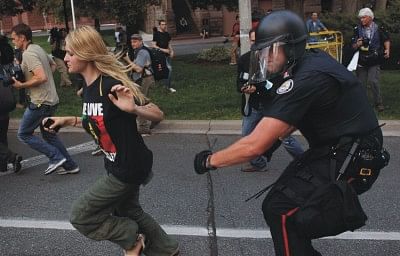Police arrest more than 500 at Toronto summit

A police officer chases a girl during protest against the G8/G20 summits in Queen's Park in Toronto, Canada on Saturday. Photo: AFP
Police made more than 500 arrests after black-clad demonstrators broke off from a crowd of peaceful protesters at the global economic summit and went on a rampage in downtown Toronto that lasted into the early morning hours, authorities said yesterday.
The roving band of protesters torched four police cruisers and shattered shop windows with baseball bats and hammers for blocks, including at police headquarters, then shed some of their black clothes, revealing other garments, and continued their rampage.
Police used shields, clubs, tear gas and pepper spray to push back the protesters who tried to head south toward the security fence surrounding the Group of 20 summit site. Some demonstrators hurled rocks and bottles at police.
The vandalism occurred just blocks from where U.S. President Barack Obama and other world leaders were meeting and staying.
"What we saw yesterday is a bunch of thugs that pretend to have a difference of opinion with policies and instead choose violence to express those so-called differences of opinion," Prime Minister Stephen Harper's chief spokesman Dimitri Soudas said yesterday.
Toronto Police Sgt Tim Burrows said Sunday that at least 412 people had been arrested in the rampage that began Saturday afternoon. Those arrested were taken to a temporary holding center constructed for the summit.
The streets of downtown Toronto were quiet at daylight, but Burrows said police were expecting a large protest later Sunday morning at a park near the detention center.
Burrows said many of the violent protesters were Canadian. He added that authorities had known of their plans for some time.
"We're not sure we have the leaders, but we have a large proportion of those people and the people who decided they wanted to be influenced by these violent protesters and join with their cause," Burrows said. "A lot of them were home grown. There's a lot of Canadian talent in the group."
Thousands of police headed to Toronto to reinforce security there after the smaller Group of Eight summit ended Saturday in Huntsville, Ontario, about 140 miles (225 kilometers) away. Security was being provided by an estimated 19,000 law enforcement officers drawn from across Canada, and security costs were estimated at more than US$900 million.
Saturday's protests began with a peaceful march, sponsored by labor unions and dubbed family friendly, which was the largest demonstration planned during the summit weekend. Its organizers had hoped to draw a crowd of 10,000, but only about half that number turned out on a rainy day.
Police in riot gear and riding bikes formed a blockade, keeping protesters from approaching the steel and concrete security fence a few blocks south of the march route. Police closed a stretch of Toronto's subway system along the protest route and the largest shopping mall downtown closed after the protest took a turned for the worse.
The black-clad demonstrators broke off from the larger crowd of peaceful protesters and began torching police cars and smashing shop windows.
Toronto Police Chief Bill Blair said the goal of the militant protesters was to draw police away from the security perimeter of the summit so that fellow protesters could attempt to disrupt the meeting.
Some police officers were struck by rocks and bottles and assaulted, but none was injured badly enough to stop working, Blair said.
"We have never seen that level of wanton criminality and vandalism and destruction on our streets," Blair said.
Previous global summit protests have turned violent. In 1999, 50,000 protesters shut down World Trade Organization sessions in Seattle as police fired tear gas and rubber bullets. There were some 600 arrests and $3 million in property damage. One man died after clashes with police at a G-20 meeting held in London in April 2009.
At the September G-20 summit in Pittsburgh, police fired canisters of pepper spray and smoke and rubber bullets at marchers.

 For all latest news, follow The Daily Star's Google News channel.
For all latest news, follow The Daily Star's Google News channel. 



Comments